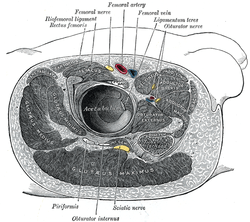Adductor brevis muscle
| Adductor brevis muscle | |
|---|---|
|
The adductor brevis and nearby muscles | |
 Structures surrounding right hip-joint. (Adductor brevis at upper right.) | |
| Details | |
| Origin | anterior surface of the inferior ramus and body of the pubis |
| Insertion | the lesser trochanter and linea aspera of the femur |
| Artery | deep femoral artery |
| Nerve | obturator nerve |
| Actions | adduction of hip |
| Identifiers | |
| Latin | Musculus adductor brevis |
| TA | A04.7.02.027 |
| FMA | 22442 |
The adductor brevis is a muscle in the thigh situated immediately deep to the pectineus and adductor longus. It belongs to the adductor muscle group. The main function of the adductor brevis is to pull the thigh medially.[1] The adductor brevis and the rest of the adductor muscle group is also used to stabilize left to right movements of the trunk, when standing on both feet, or to balance when standing on a moving surface. The adductor muscle group is used pressing the thighs together to ride a horse, and kicking with the inside of the foot in soccer or swimming. Last, they contribute to flexion of the thigh when running or against resistance (squats, jumping, etc.).[2]
Structure
It is somewhat triangular in form, and arises by a narrow origin from the outer surfaces of the superior and inferior rami of the pubis, between the gracilis and obturator externus.
Its fibers, passing backward, lateralward, and downward, are inserted, by an aponeurosis, into the line leading from the lesser trochanter to the linea aspera and into the upper part of the linea aspera, immediately behind the pectineus and upper part of the adductor longus.
Relations
By its anterior surface, the adductor brevis is in relation with the pectineus, adductor longus, and anterior branches of the obturator artery, the obturator vein, and the obturator nerve.
By its posterior surface with the adductor magnus and the posterior branches of the obturator artery, the obturator vein, and the obturator nerve.
By its outer border with the obturator externus, and the iliopsoas. By its inner border with the gracilis and adductor magnus.
It is pierced near its insertion by the middle perforating artery.[3]
Innervation
The adductor brevis is innervated dually by the anterior and posterior branches of the obturator nerve.[4]
Function
The muscle is primarily known as a hip adductor. It also functions as a hip flexor. Whether it acts to rotate the femur laterally or medially is dependent on position.
References
This article incorporates text in the public domain from the 20th edition of Gray's Anatomy (1918)
- ↑ Saladin, Kenneth (2010). Anatomy & Physiology: The Unity of Form and Function (6th ed.). McGraw-Hill. ISBN 978-0-07-337825-1.
- ↑ Moore, Keith. Clinically Oriented Anatomy (5th ed.). Lippincott Williams & Wilkins.
- ↑ Wilson, Erasmus (1851). The anatomist's vade mecum: a system of human anatomy. pp. 260–1.
- ↑ Miura M, Nakamura E, Kato S, Usui T, Miyauchi R (August 1994). "The true nature of the adductor brevis dually innervated by the anterior and posterior branches of the obturator nerve in humans". Okajimas Folia Anatomica Japonica. 71 (2–3): 67–82. doi:10.2535/ofaj1936.71.2-3_67. PMID 7808725.
Additional images
-

Deep muscles of the medial femoral region.
External links
- -952827827 at GPnotebook
- Cross section image: pembody/body18b - Plastination Laboratory at the Medical University of Vienna
- Cross section image: pelvis/pelvis-e12-15 - Plastination Laboratory at the Medical University of Vienna
- PTCentral